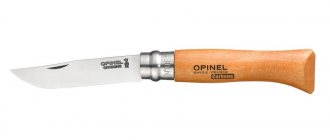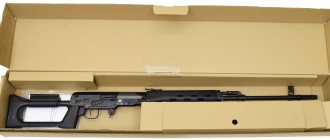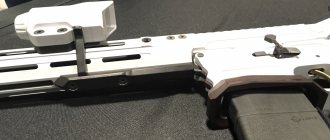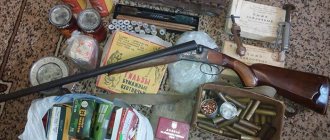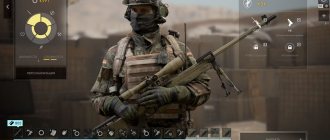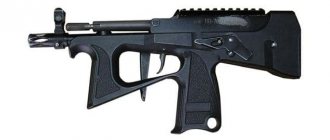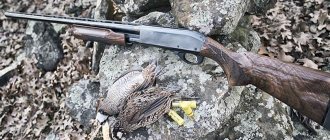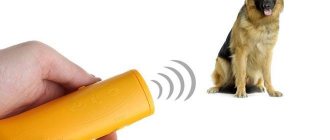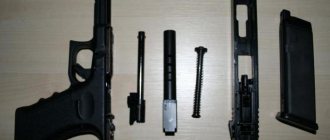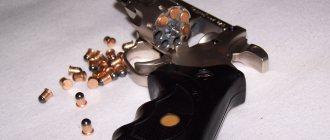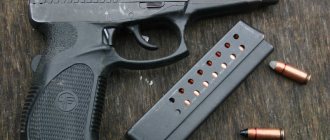This term has other meanings, see Caliber (meanings).
Bullets of various calibers
Caliber
(from the French caliber) - the diameter of the bore along the rifling or margins; one of the main quantities that determine the power of a firearm.
The caliber is measured for smooth-bore weapons by the internal diameter of the barrel, for rifled weapons - either by the distance between the opposite fields of the rifling (in the countries of the former USSR) or by the distance between the bottom of the opposite rifling (NATO), for projectiles (bullets) the caliber is determined by their largest diameter[1] . Guns with a conical barrel are characterized by input and output calibers.
Caliber of rifled small arms
Methods for measuring (A, B) the caliber of barrels of various sections Smooth-bore weapons Rifled weapons Polygonal rifling
The caliber is indicated both on the weapon and on the cartridges. However, with the same caliber numbers, the diameters of the bores (and bullets) may differ. For example, the 9x18 Makarov and 9x19 Parabellum (or 9x17 Browning) cartridges have the same caliber of 9 mm. The Makarov pistol has a distance between fields (the smallest bore diameter) of 9 mm, a distance between grooves of 9.27 mm, and a case diameter of 9.25 mm. For weapons for the second ammunition, the distance between fields is 8.8 mm, the distance between rifling is 9 mm, and the case diameter is 9.03 mm.
The caliber of rifled small arms in countries that use the English system of measures is measured in fractions of an inch: in the USA - in hundredths (0.01 inches), in the UK - in thousandths (0.001 inches). In the entry, the zero of the integer part of the number and the designation of the unit of measurement (inch) are omitted, and a dot is used as the decimal separator: .45
,
.450
.
In Russian texts, traditional English and American calibers are written in the same way (with a period rather than a comma, the decimal separator adopted in Russia): caliber .45
,
caliber .450
;
colloquially: forty-five caliber
,
four hundred and fifty caliber
.
In Russia until 1917 and a number of other countries, caliber was measured in lines. One line equals 1/10 inch (0.254 cm or 2.54 mm). In modern speech, the name “three-line” has taken root, which literally means a rifle of the 1891 model (Mosin system) of three-line caliber.
In countries that use the metric system of measures (in particular, in Russia), the caliber is measured in millimeters; in the designation, the length of the sleeve is added through the multiplication sign: 9 × 18 mm
.
It must be taken into account that the length of the cartridge case is not a characteristic of the caliber, but a characteristic of the cartridge. With the same caliber, cartridges can be of different lengths and have different case lengths. In the West, such digital recording is used mainly for military cartridges. For civilian cartridges, the name of the company or cartridge standard is usually added to the caliber: .45 Colt
,
.41 S&W
,
.38 Super
,
.357 Magnum
,
.220 Russian
.
There are also more complex designations, for example, several designations for the same cartridge: nine millimeters, Browning, short
;
three hundred eighty, auto
;
nine by seventeen
.
This state of affairs is due to the fact that almost every arms company has its own patented cartridges of different characteristics, and a foreign cartridge adopted for service or for civilian use receives a new designation [ source not specified 441 days
].
Classification of small arms calibers:
- small-caliber (less than 6.5 mm)[2],
- normal caliber (6.5-9.0 mm),
- large-caliber (9.0-20.0 mm) [ source not specified 441 days
].
Caliber up to 20 mm - small arms, 20 mm and above - artillery[3].
As a rule, small arms differ from artillery weapons by the type of ammunition. Small arms are designed to fire bullets, while artillery systems fire projectiles. At the same time, for rifled firearms, one of the differences between bullets and shells is that the bullets, when passing through the bore, cut into the rifling with their shell. This creates a torque that increases the stability of the bullet in flight. When fired, the projectile is given rotation with the help of driving belts (made from materials of less hardness than the shell of the projectile body) [ source not specified 441 days
].
The most common calibers of pistols, rifles and machine guns:
- .577 (14.7 mm) - the largest of the serial ones, the Eley revolver (Great Britain);
- .50 (12.7 mm) - used for heavy machine guns and sniper rifles, as well as for the famous brand of Desert Eagle pistol;
- .45 (11.43 mm) - the “national” caliber of the USA, the most common in the Wild West; in 1911, the Colt M1911 self-loading pistol of this caliber entered service with the Army and Navy and, with minor changes in 1926, served until 1985, when the US armed forces switched to 9 mm for the Beretta 92; continues to be used in civil circulation;
- .40 (10.2 mm) is a relatively new pistol caliber; provides better efficiency, for which it has gained great popularity in US law enforcement agencies;
- .38; .357 (9 mm), is currently considered the best for short-barreled weapons (less - the cartridge is “weak”, more - the gun is too bulky and heavy, strong recoil);
- .30 (7.62 mm) - caliber of ammunition for the Nagan system revolver, pistol, Mosin rifle, Simonov self-loading carbine, Kalashnikov assault rifle, Kalashnikov light machine gun, Dragunov sniper rifle, PK/PKM/PKT machine guns;
- .22 LR (5.6 mm) - caliber of ammunition for the TOZ-8 rifle (TOZ-10, TOZ-12);
- .223 (5.56 mm) - caliber of ammunition for the M16 automatic rifle;
- 5.45 mm - AK-74 ammunition caliber;
- 2.7 mm - the smallest serial caliber; used in the Hummingbird pistol of the Franz Pfannl system (Austria) [ source not specified 441 days
].
Hunting in Karelia
Going after a wild boar or bear without a large-caliber carbine is perceived by some hunters as suicide, because you should behave more carefully with such animals. Here you need a weapon that can instantly cause serious destruction to the beast in order to prevent wounded animals.
Attention
A wounded animal is a huge threat to any person.
What calibers of hunting rifles exist? Contents of the article:
- 1 What calibers of hunting rifles exist?
- 2 Caliber 5.6
- 3 Foreign 223 Remington
- 4 Caliber 243 Winchester
- 5 Caliber 7.62x39
- 6 Universal caliber 308 Winchester
Any type of weapon has its own classification according to a variety of criteria.
If we talk about rifled weapons, they are also divided according to caliber into several groups.
Info
But if you are going to shoot far, then you should not go beyond 8 mm in caliber.
You should not assume that the larger the caliber, the easier it is to use on any animal.
I assure you, if a carbine chambered for 9.3x62 or .375H&H hits a roe deer or a fox, all that will remain is “horns and legs.” And who needs it? CALIBER IS GAME If everything is more or less clear with the caliber, then another question arises: why do we need so many different types of cartridges? The army needed cartridges that could easily hit the enemy and incapacitate them even if they were wounded.
Important
For hunting, it was necessary to have a weapon that could stop the animal “in place,” while not weighing very much and shooting far enough.
In different countries, different calibers have taken root for hunting a wide variety of game.
Russian artillery caliber
In Europe, the term artillery caliber
appeared in 1546, when Georg Hartmann[de] from Nuremberg developed a device called the Hartmann scale. It was a prismatic tetrahedral ruler. Units of measurement (inches) were marked on one face, and the actual dimensions (based on weight in pounds) of iron, lead and stone cores, respectively, were marked on the other three.
Examples (approximately):
- 1 face - mark of 1 lb lead core - corresponds to 1.5 inches;
- 2nd face - mark of an iron core weighing 1 pound - corresponds to 2.5 inches;
- The 3rd face - the mark of a stone core weighing 1 pound - corresponds to 3 inches.
Thus, knowing the size or weight of the projectile, it was possible to easily assemble, and most importantly, manufacture ammunition. A similar system existed in the world for about three hundred years.
In Russia, before Peter I, there were no uniform standards. The cannons and squeaks available in the army were each characterized separately by the weight of the projectile, in Russian national units. Pre-Petrine inventories mention guns from 1/8 hryvnia to a pood. At the beginning of the 18th century, on the instructions of Peter I, Feldmaster General Count Bruce developed a domestic caliber system based on the Hartmann scale. It divided the guns according to the artillery weight of the projectile (cast iron core). The unit of measurement was the artillery pound - a cast iron ball with a diameter of 2 inches and weighing 115 spools (about 490 grams). It did not matter what types of projectiles the gun fired - buckshot, bombs or anything else. Only the theoretical artillery weight that a gun could fire given its size was taken into account. Tables were also developed correlating artillery weight (caliber) with bore diameter. Artillery officers were required to operate with both calibers and diameters. In the “Naval Charter” (St. Petersburg, 1720), in chapter seven “On the artillery officer, or constapelle”, in paragraph 2 it is written: “You must measure the cannonballs to see if their diameters are similar to the calibers of the guns and place them on the ship according to your places." This system was introduced by royal decree in 1707 and lasted for more than a century and a half.
Examples:
- 3-pounder gun, 3-pounder gun - official names;
- artillery weight 3 pounds - the main characteristic of the gun;
- size 2.8 inches - bore diameter, an auxiliary characteristic of the gun.
In practice, it was a small cannon that fired cannonballs weighing about 1.5 kg and had a caliber (in our understanding) of about 71 mm.
Kozlovsky David Evstafievich in his book[4] gives a translation of Russian artillery weight[5] into metric calibers:
- 3 lbs - 76 mm,
- 4 lbs - 88 mm,
- 6 lbs - 96 mm,
- 12 lbs - 120 mm,
- 18 lbs - 137 mm,
- 24 lbs - 152 mm,
- 60 lbs - 195 mm.
Explosive shells (bombs) occupied a special place in this system. Their weight was measured in poods (1 pood - 40 trade pounds - equals approximately 16.38 kg). This is due to the fact that the bombs were hollow, with explosives inside, that is, made of materials of different densities. During their production, it was much more convenient to operate with generally accepted weight units.
Kozlovsky gives the following relationships:
- 1/4 pood - 120 mm,
- 1/2 pood - 152 mm,
- 1 pood - 196 mm,
- 2 pounds - 245 mm,
- 3 pounds - 273 mm,
- 5 poods - 333 mm.
A special weapon was intended for bombs - a bombard, or mortar. Its tactical and technical characteristics, combat missions and calibration system allow us to speak of a special type of artillery. In practice, small bombards often fired ordinary cannonballs, and then the same gun had different calibers - a general one of 12 pounds and a special one of 10 pounds.
The introduction of calibers, among other things, became a good material incentive for soldiers and officers. Thus, in the “Naval Charter”, printed in St. Petersburg in 1720, in the chapter “On rewarding” the amounts of reward payments for guns taken from the enemy are given:
- 30 pound - 300 rubles,
- 24 pound - 250 rubles,
- 18 pound - 210 rubles,
- 12 pound - 170 rubles,
- 8 pound - 130 rubles,
- 6 pound - 90 rubles,
- 4- or 3-pound - 50 rubles,
- 2 pound or less - 15 rubles.
In the second half of the 19th century, with the introduction of rifled artillery, the scale was adjusted due to changes in the characteristics of the projectile, but the principle remained the same.
Notes
- It must be taken into account that the projectiles have sealing belts made of soft metal, which prevent the breakthrough of gases between the projectile and the walls of the barrel bore. According to the obturating belts, the largest diameter of the projectile will be greater than its caliber. For example, copper sealing bands of 125-mm tank smoothbore gun shells ensure firing with barrel wear of up to 3.3 mm (that is, the actual caliber of a 125-mm gun with wear can be 128 mm).
- In the USSR (Russian Federation), the term small-caliber
is usually used to refer to rimfire cartridges.
low-pulse has
also been adopted . - There are also exceptions:
- 4th hunting caliber, also used in signal pistols and the KS-23 carbine;
there are rifles chambered for 20 mm artillery cartridges;
- under-barrel grenade launchers and other systems for the same grenades are also classified as small arms;
- 15-mm aircraft guns from the Second World War.
- https://talks.guns.ru/forummessage/42/161.html “History of the material part of artillery” (Moscow, 1946)
- table
Free legal assistance
Hunting (and other shotgun) calibers For hunting weapons, calibers are measured in the number of balls that can be cast from one pound of lead. This explains why a 12-gauge hunting weapon is larger than a 16-gauge - a round bullet cast from 1/12 of a pound of lead is larger than a bullet cast from 1/16 of a pound.
Next in descending order: 20, 16, 24, 28, 32 or .410. Moreover, the spread of the latter caliber was facilitated by the release of the Saiga carbine of this caliber. The calibers of hunting cartridges for smooth-bore weapons are designated by the following digital indices - 12/65.
